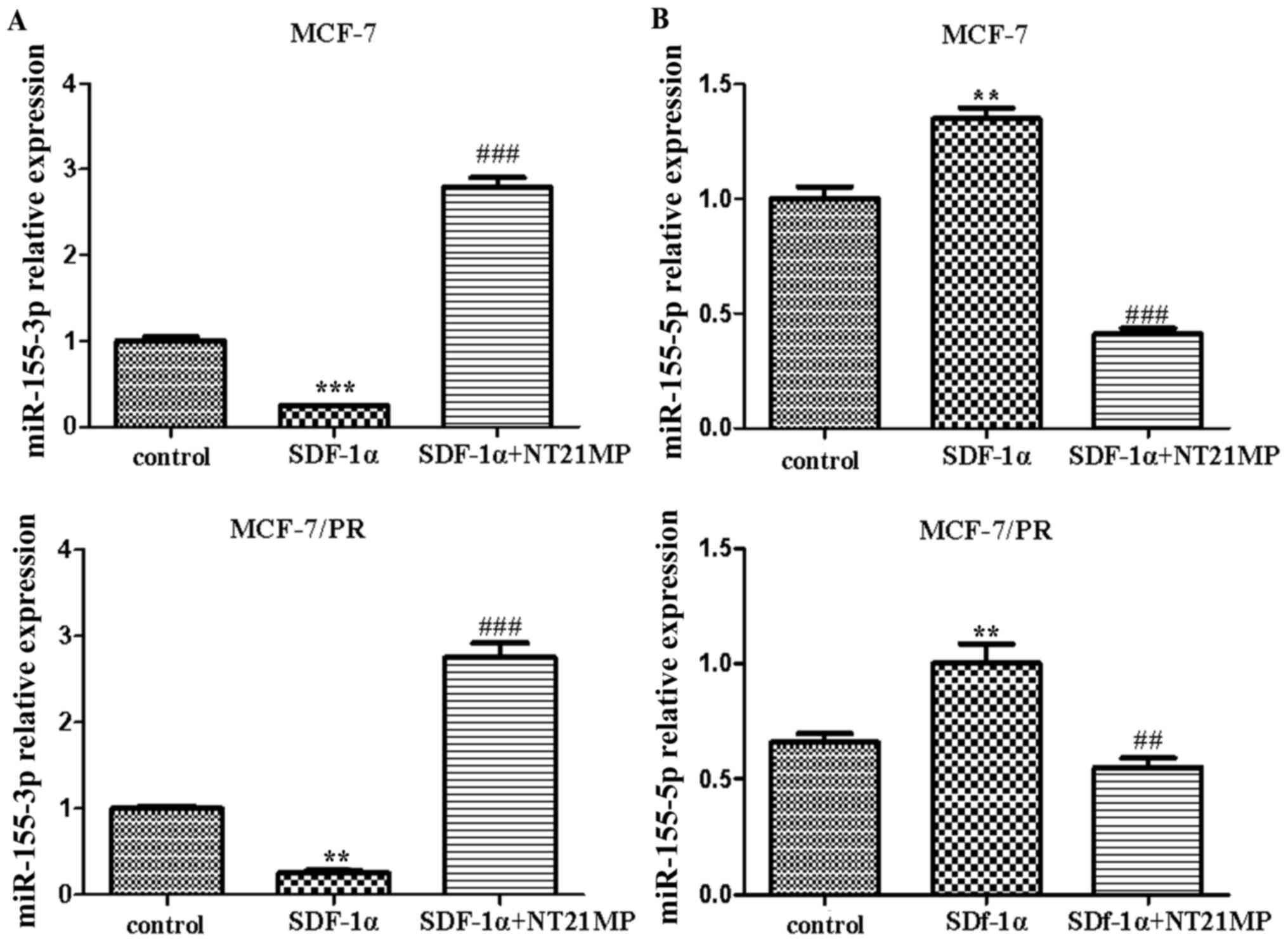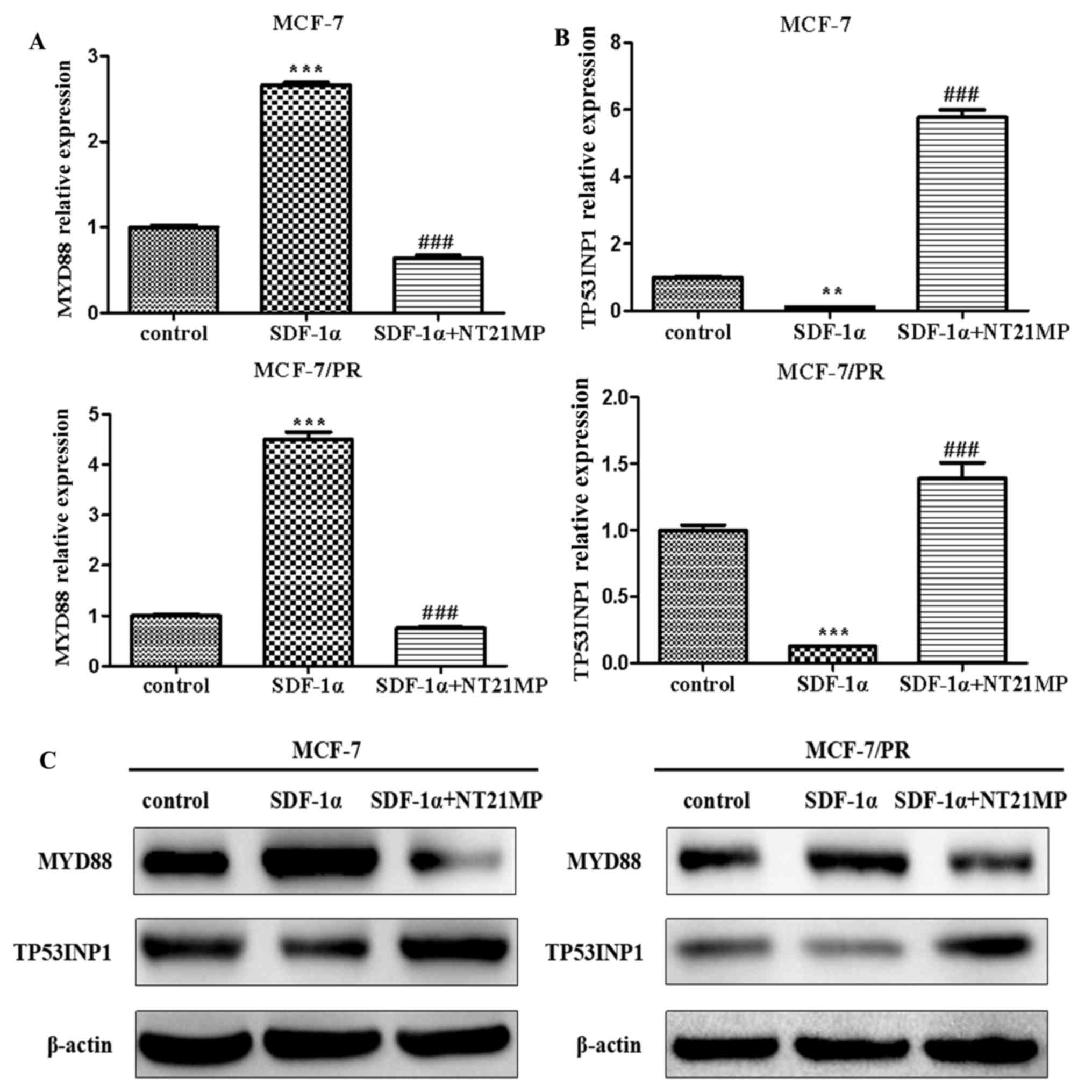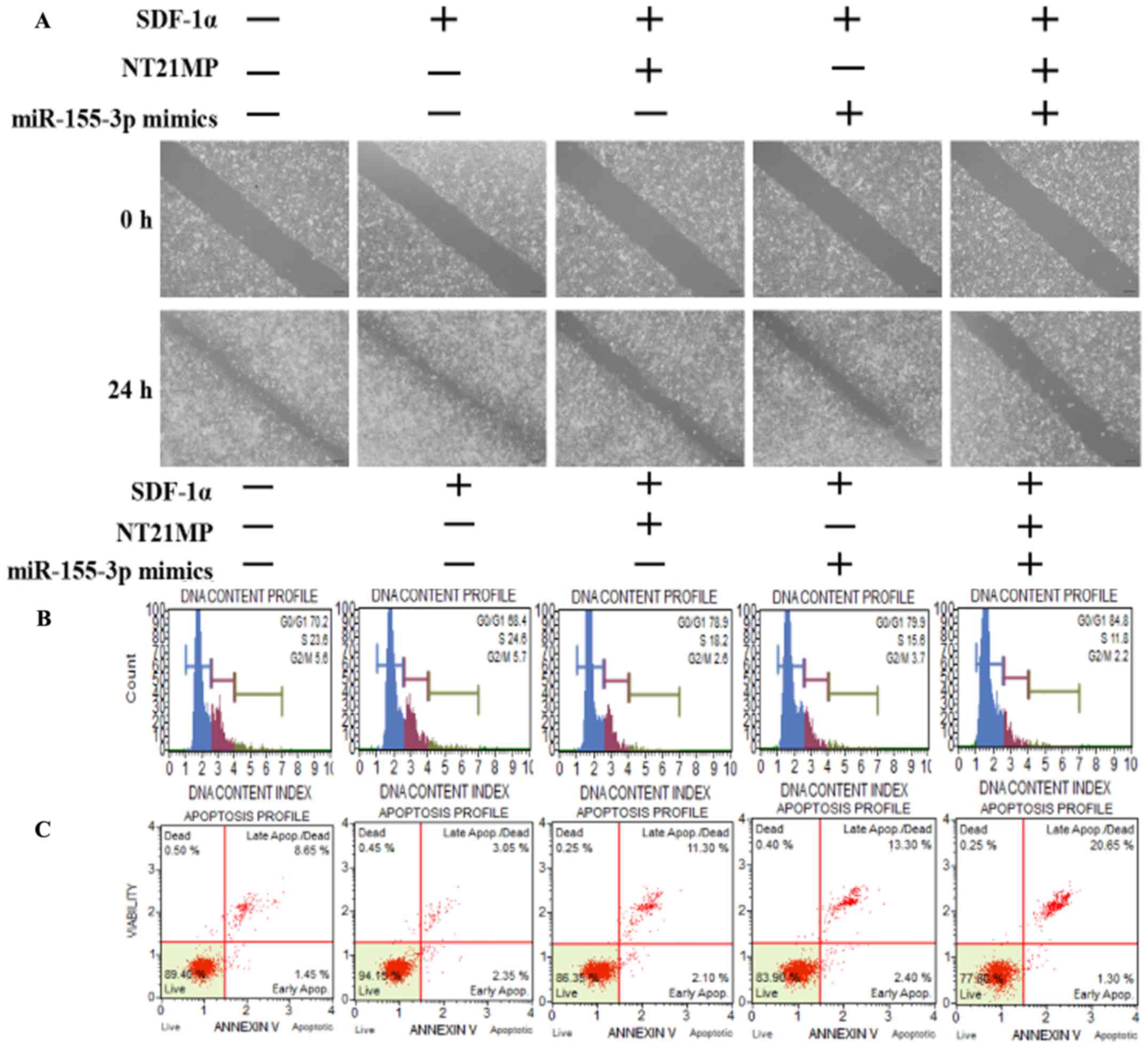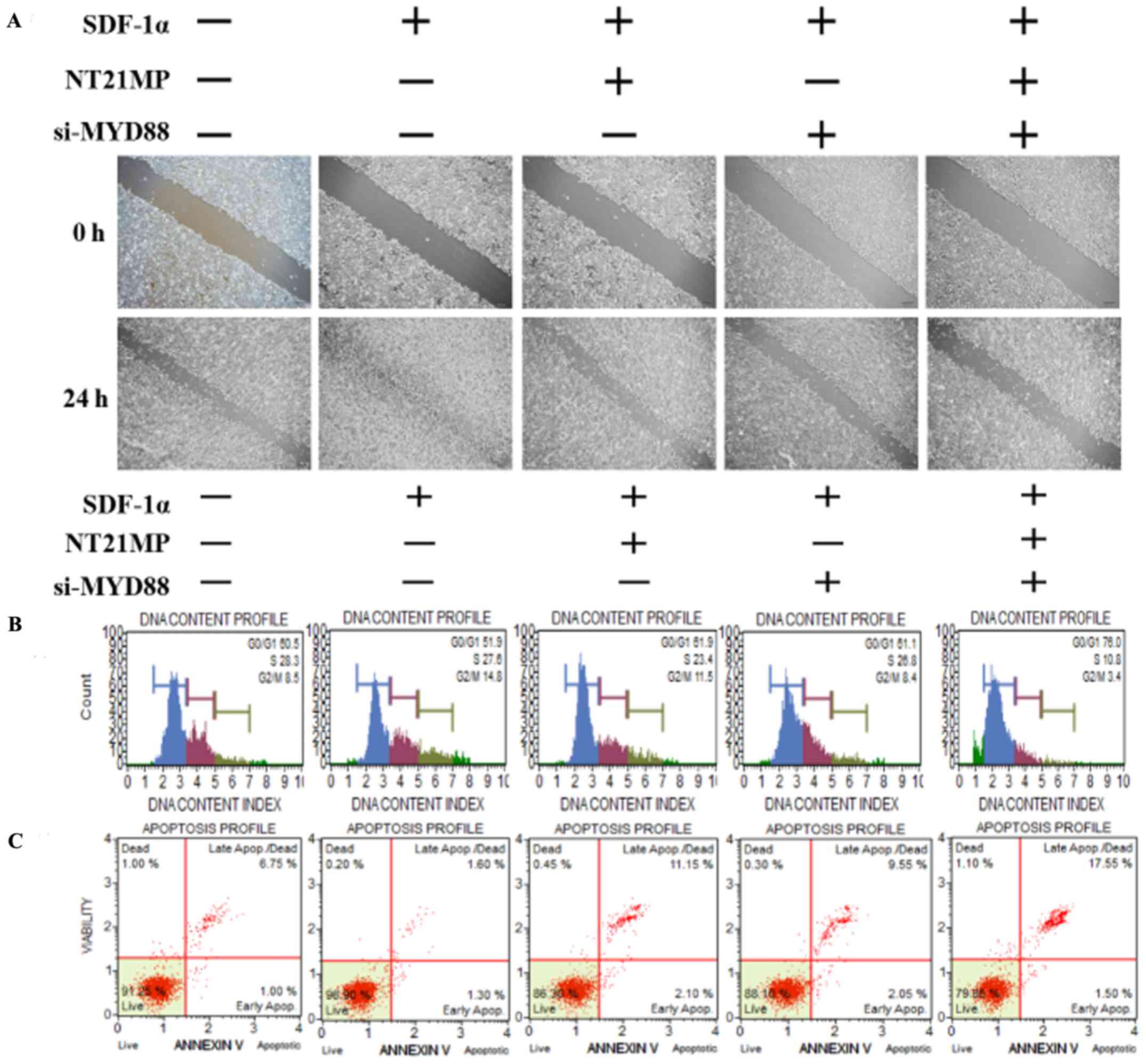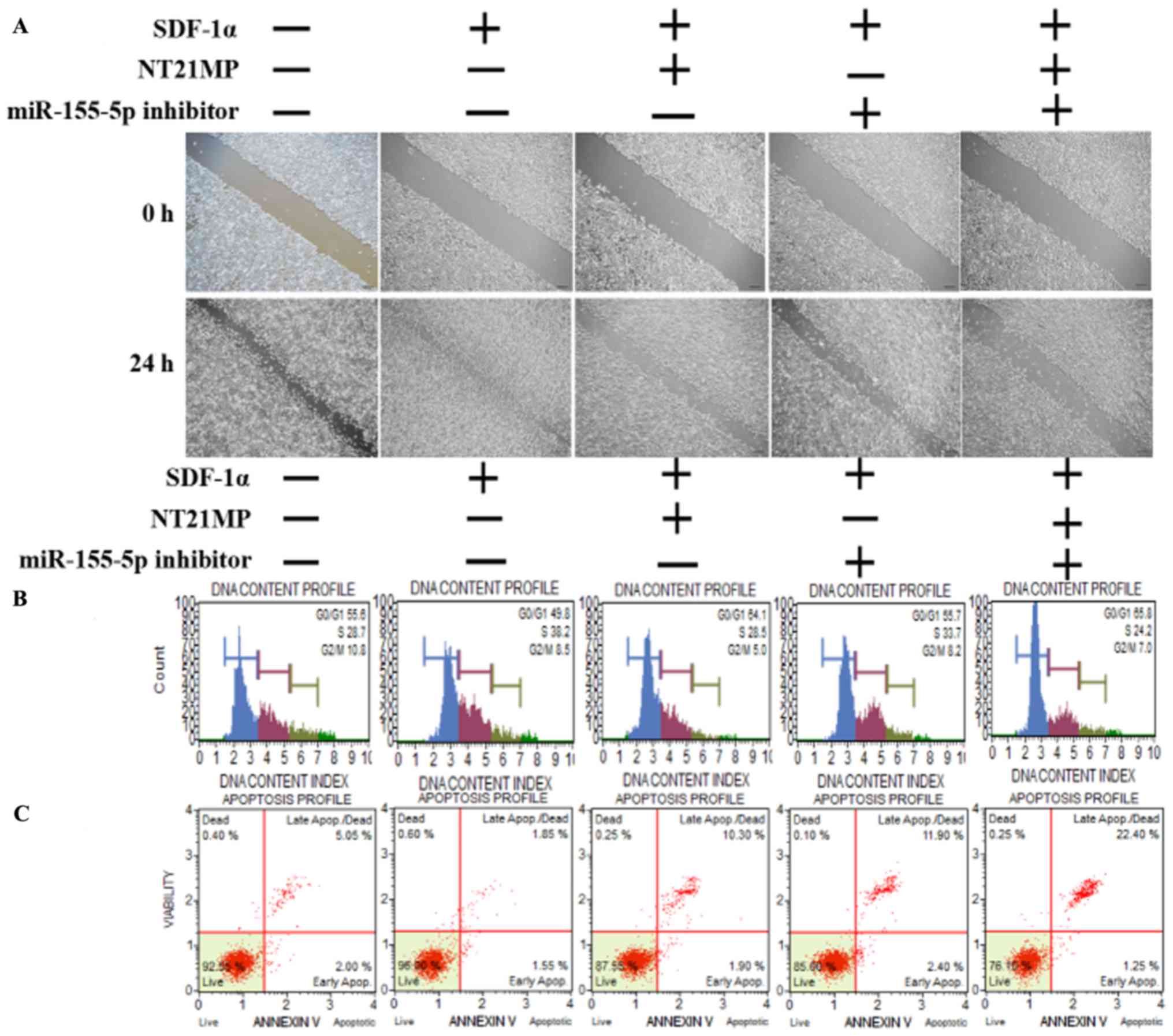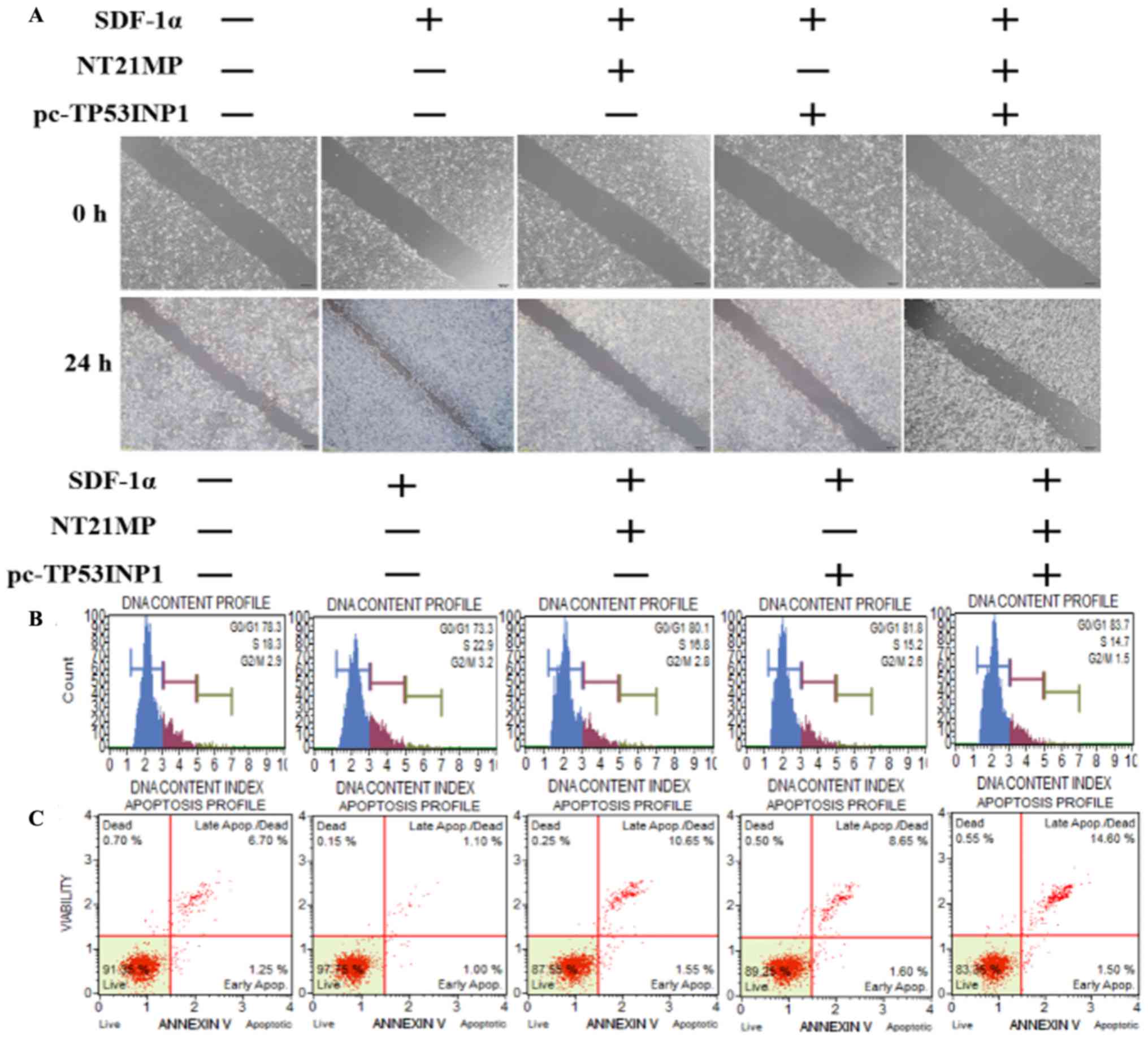|
1
|
Weigelt B, Peterse JL and van 't Veer LJ:
Breast cancer metastasis: Markers and models. Nat Rev Cancer.
5:591–602. 2005. View
Article : Google Scholar : PubMed/NCBI
|
|
2
|
Li Y, Jin K, van Pelt GW, van Dam H, Yu X,
Mesker WE, Ten Dijke P, Zhou F and Zhang L: c-Myb enhances breast
cancer invasion and metastasis through the Wnt/β-catenin/Axin2
pathway. Cancer Res. 76:3364–3375. 2016. View Article : Google Scholar : PubMed/NCBI
|
|
3
|
Hackshaw A, Roughton M, Forsyth S, Monson
K, Reczko K, Sainsbury R and Baum M: Long-term benefits of 5 years
of tamoxifen: 10-year follow-up of a large randomized trial in
women at least 50 years of age with early breast cancer. J Clin
Oncol. 29:1657–1663. 2011. View Article : Google Scholar : PubMed/NCBI
|
|
4
|
Trail PA, Dubowchik GM and Lowinger TB:
Antibody drug conjugates for treatment of breast cancer: Novel
targets and diverse approaches in ADC design. Pharmacol Ther.
181:126–142. 2018. View Article : Google Scholar
|
|
5
|
Phuong NT, Lim SC, Kim YM and Kang KW:
Aromatase induction in tamoxifen-resistant breast cancer: Role of
phosphoinositide 3-kinase-dependent CREB activation. Cancer Lett.
351:91–99. 2014. View Article : Google Scholar : PubMed/NCBI
|
|
6
|
Kim YJ, Sung D, Oh E, Cho Y, Cho TM,
Farrand L, Seo JH and Kim JY: Flubendazole overcomes trastuzumab
resistance by targeting cancer stem-like properties and HER2
signaling in HER2-positive breast cancer. Cancer Lett. 412:118–130.
2018. View Article : Google Scholar
|
|
7
|
Vuylsteke P, Huizing M, Petrakova K,
Roylance R, Laing R, Chan S, Abell F, Gendreau S, Rooney I, Apt D,
et al: Pictilisib PI3Kinase inhibitor (a phosphatidylinositol
3-kinase [PI3K] inhibitor) plus paclitaxel for the treatment of
hormone receptor-positive, HER2-negative, locally recurrent, or
metastatic breast cancer: Interim analysis of the multicentre,
placebo-controlled, phase II randomised PEGGY study. Ann Oncol.
27:2059–2066. 2016. View Article : Google Scholar : PubMed/NCBI
|
|
8
|
Pellegrino B, Boggiani D, Tommasi C, Palli
D and Musolino A: Nab-paclitaxel after docetaxel hypersensitivity
reaction: Case report and literature review. Acta Biomed.
88:329–333. 2017.PubMed/NCBI
|
|
9
|
Liu T, Sun H, Liu S, Yang Z, Li L, Yao N,
Cheng S, Dong X, Liang X, Chen C, et al: The suppression of DUSP5
expression correlates with paclitaxel resistance and poor prognosis
in basal-like breast cancer. Int J Med Sci. 15:738–747. 2018.
View Article : Google Scholar : PubMed/NCBI
|
|
10
|
Iorio MV, Ferracin M, Liu CG, Veronese A,
Spizzo R, Sabbioni S, Magri E, Pedriali M, Fabbri M, Campiglio M,
et al: MicroRNA gene expression deregulation in human breast
cancer. Cancer Res. 65:7065–7070. 2005. View Article : Google Scholar : PubMed/NCBI
|
|
11
|
Zhang F, Wang B, Long H, Yu J, Li F, Hou H
and Yang Q: Decreased miR-124-3p expression prompted breast cancer
cell progression mainly by targeting Beclin-1. Clin Lab.
62:1139–1145. 2016. View Article : Google Scholar : PubMed/NCBI
|
|
12
|
Han L, Liu B, Jiang L, Liu J and Han S:
MicroRNA-497 downregulation contributes to cell proliferation,
migration, and invasion of estrogen receptor alpha negative breast
cancer by targeting estrogen-related receptor alpha. Tumour Biol.
37:13205–13214. 2016. View Article : Google Scholar : PubMed/NCBI
|
|
13
|
Gregory PA, Bert AG, Paterson EL, Barry
SC, Tsykin A, Farshid G, Vadas MA, Khew-Goodall Y and Goodall GJ:
The miR-200 family and miR-205 regulate epithelial to mesenchymal
transition by targeting ZEB1 and SIP1. Nat Cell Biol. 10:593–601.
2008. View
Article : Google Scholar : PubMed/NCBI
|
|
14
|
Samaeekia R, Adorno-Cruz V, Bockhorn J,
Chang YF, Huang S, Prat A, Ha N, Kibria G, Huo D, Zheng H, et al:
miR-206 inhibits stemness and metastasis of breast cancer by
targeting MKL1/IL11 pathway. Clin Cancer Res. 23:1091–1103. 2017.
View Article : Google Scholar
|
|
15
|
Yu T, Li J, Yan M, Liu L, Lin H, Zhao F,
Sun L, Zhang Y, Cui Y, Zhang F, et al: MicroRNA-193a-3p and -5p
suppress the metastasis of human non-small-cell lung cancer by
down-regulating the ERBB4/PIK3R3/mTOR/S6K2 signaling pathway.
Oncogene. 34:413–423. 2015. View Article : Google Scholar
|
|
16
|
Zhou H, Huang X, Cui H, Luo X, Tang Y,
Chen S, Wu L and Shen N: miR-155 and its star-form partner miR-155*
cooperatively regulate type I interferon production by human
plasmacytoid dendritic cells. Blood. 116:5885–5894. 2010.
View Article : Google Scholar : PubMed/NCBI
|
|
17
|
Josson S, Gururajan M, Hu P, Shao C, Chu
GY, Zhau HE, Liu C, Lao K, Lu CL, Lu YT, et al: miR-409-3p/-5p
promotes tumorigenesis, epithelial-to-mesenchymal transition, and
bone metastasis of human prostate cancer. Clin Cancer Res.
20:4636–4646. 2014. View Article : Google Scholar : PubMed/NCBI
|
|
18
|
Matsushita R, Seki N, Chiyomaru T,
Inoguchi S, Ishihara T, Goto Y, Nishikawa R, Mataki H, Tatarano S,
Itesako T, et al: Tumour-suppressive microRNA-144-5p directly
targets CCNE1/2 as potential prognostic markers in bladder cancer.
Br J Cancer. 113:282–289. 2015. View Article : Google Scholar : PubMed/NCBI
|
|
19
|
Matsushita R, Yoshino H, Enokida H, Goto
Y, Miyamoto K, Yonemori M, Inoguchi S, Nakagawa M and Seki N:
Regulation of UHRF1 by dual-strand tumor-suppressor microRNA-145
(miR-145-5p and miR-145-3p): Inhibition of bladder cancer cell
aggressiveness. Oncotarget. 7:28460–28487. 2016. View Article : Google Scholar : PubMed/NCBI
|
|
20
|
Yonemori M, Seki N, Yoshino H, Matsushita
R, Miyamoto K, Nakagawa M and Enokida H: Dual tumor-suppressors
miR-139-5p and miR-139-3p targeting matrix metalloprotease 11 in
bladder cancer. Cancer Sci. 107:1233–1242. 2016. View Article : Google Scholar : PubMed/NCBI
|
|
21
|
Sakaguchi T, Yoshino H, Yonemori M,
Miyamoto K, Sugita S, Matsushita R, Itesako T, Tatarano S, Nakagawa
M and Enokida H: Regulation of ITGA3 by the dual-stranded
microRNA-199 family as a potential prognostic marker in bladder
cancer. Br J Cancer. 116:1077–1087. 2017. View Article : Google Scholar : PubMed/NCBI
|
|
22
|
Zhang H, Xing AY, Ma RR, Wang YW, Liu YH
and Gao P: Diagnostic value of miRNA-96-5p/3p in dysplastic nodules
and well-differentiated small hepatocellular carcinoma. Hepatol
Res. 46:784–793. 2016. View Article : Google Scholar
|
|
23
|
Yang Q, Zhang F, Ding Y, Huang J, Chen S,
Wu Q, Wang Z, Wang Z and Chen C: Antitumour activity of the
recombination polypeptide GST-NT21MP is mediated by inhibition of
CXCR4 pathway in breast cancer. Br J Cancer. 110:1288–1297. 2014.
View Article : Google Scholar : PubMed/NCBI
|
|
24
|
Yang Q, Wu H, Wang H, Li Y, Zhang L, Zhu
L, Wang W, Zhou J, Fu Y, Chen S, et al: N-terminal polypeptide
derived from vMIP-II exerts its antitumor activity by inhibiting
the CXCR4 pathway in human glioma. Int J Oncol. 50:1160–1174. 2017.
View Article : Google Scholar :
|
|
25
|
Wang Y, Wang H, Ding Y, Li Y, Chen S,
Zhang L, Wu H, Zhou J, Duan K, Wang W, et al: N-peptide of vMIP-II
reverses paclitaxel- resistance by regulating miRNA-335 in breast
cancer. Int J Oncol. 51:918–930. 2017. View Article : Google Scholar : PubMed/NCBI
|
|
26
|
Livak KJ and Schmittgen TD: Analysis of
relative gene expression data using real-time quantitative PCR and
the 2(-Delta Delta C(T)) Method. Methods. 25:402–408. 2001.
View Article : Google Scholar
|
|
27
|
Tang B, Xiao B, Liu Z, Li N, Zhu ED, Li
BS, Xie QH, Zhuang Y, Zou QM and Mao XH: Identification of MyD88 as
a novel target of miR-155, involved in negative regulation of
Helicobacter pylori-induced inflammation. FEBS Lett. 584:1481–1486.
2010. View Article : Google Scholar : PubMed/NCBI
|
|
28
|
Rabanal C, Ruiz R, Neciosup S and Gomez H:
Metronomic chemotherapy for non-metastatic triple negative breast
cancer: Selection is the key. World J Clin Oncol. 8:437–446. 2017.
View Article : Google Scholar
|
|
29
|
Jones SK and Merkel OM: Tackling breast
cancer chemore-sistance with nano-formulated siRNA. Gene Ther.
23:821–828. 2016. View Article : Google Scholar : PubMed/NCBI
|
|
30
|
Monteiro IP, Madureira P, de Vasconscelos
A, Pozza DH and de Mello RA: Targeting HER family in HER2-positive
metastatic breast cancer: Potential biomarkers and novel targeted
therapies. Pharmacogenomics. 16:257–271. 2015. View Article : Google Scholar
|
|
31
|
Mi Y, Zhang D, Jiang W, Weng J, Zhou C,
Huang K, Tang H, Yu Y, Liu X, Cui W, et al: miR-181a-5p promotes
the progression of gastric cancer via RASSF6-mediated MAPK
signalling activation. Cancer Lett. 389:11–22. 2017. View Article : Google Scholar : PubMed/NCBI
|
|
32
|
Emmrich S, Engeland F, El-Khatib M, Henke
K, Obulkasim A, Schöning J, Katsman-Kuipers JE, Michel Zwaan C,
Pich A, Stary J, et al: miR-139-5p controls translation in myeloid
leukemia through EIF4G2. Oncogene. 35:1822–1831. 2016. View Article : Google Scholar
|
|
33
|
Bahrami A, Aledavood A, Anvari K,
Hassanian SM, Maftouh M, Yaghobzade A, Salarzaee O, ShahidSales S
and Avan A: The prognostic and therapeutic application of microRNAs
in breast cancer: Tissue and circulating microRNAs. J Cell Physiol.
233:774–786. 2018. View Article : Google Scholar
|
|
34
|
Tang B, Lei B, Qi G, Liang X, Tang F, Yuan
S, Wang Z, Yu S and He S: MicroRNA-155-3p promotes hepatocellular
carcinoma formation by suppressing FBXW7 expression. J Exp Clin
Cancer Res. 35:932016. View Article : Google Scholar : PubMed/NCBI
|
|
35
|
Yim RL, Wong KY, Kwong YL, Loong F, Leung
CY, Chu R, Lam WW, Hui PK, Lai R and Chim CS: Methylation of
miR-155-3p in mantle cell lymphoma and other non-Hodgkin's
lymphomas. Oncotarget. 5:9770–9782. 2014. View Article : Google Scholar : PubMed/NCBI
|
|
36
|
Ouyang M, Li Y, Ye S, Ma J, Lu L, Lv W,
Chang G, Li X, Li Q, Wang S, et al: MicroRNA profiling implies new
markers of chemoresistance of triple-negative breast cancer. PLoS
One. 9:e962282014. View Article : Google Scholar : PubMed/NCBI
|
|
37
|
Luan T, Zhang X, Wang S, Song Y, Zhou S,
Lin J, An W, Yuan W, Yang Y, Cai H, et al: Long non-coding RNA MIAT
promotes breast cancer progression and functions as ceRNA to
regulate DUSP7 expression by sponging miR-155-5p. Oncotarget.
8:76153–76164. 2017. View Article : Google Scholar : PubMed/NCBI
|
|
38
|
Hassan F, Islam S, Tumurkhuu G, Naiki Y,
Koide N, Mori I, Yoshida T and Yokochi T: Intracellular expression
of toll-like receptor 4 in neuroblastoma cells and their
unresponsiveness to lipopolysaccharide. BMC Cancer. 6:2812006.
View Article : Google Scholar : PubMed/NCBI
|
|
39
|
Ma FJ, Liu ZB, Hu X, Ling H, Li S, Wu J
and Shao ZM: Prognostic value of myeloid differentiation primary
response 88 and Toll-like receptor 4 in breast cancer patients.
PLoS One. 9:e1116392014. View Article : Google Scholar : PubMed/NCBI
|
|
40
|
Chow A, Zhou W, Liu L, Fong MY, Champer J,
Van Haute D, Chin AR, Ren X, Gugiu BG, Meng Z, et al: Macrophage
immunomodulation by breast cancer-derived exosomes requires
Toll-like receptor 2-mediated activation of NF-κB. Sci Rep.
4:57502014. View Article : Google Scholar
|
|
41
|
Shi M, Yao Y, Han F and Li Y and Li Y:
MAP1S controls breast cancer cell TLR5 signaling pathway and
promotes TLR5 signaling-based tumor suppression. PLoS One.
9:e868392014. View Article : Google Scholar : PubMed/NCBI
|
|
42
|
Zhou L, Liu Z, Wang Z, Yu S, Long T, Zhou
X and Bao Y: Astragalus polysaccharides exerts immunomodulatory
effects via TLR4-mediated MyD88-dependent signaling pathway in
vitro and in vivo. Sci Rep. 7:448222017. View Article : Google Scholar : PubMed/NCBI
|
|
43
|
Ge X, Cao Z, Gu Y, Wang F, Li J, Han M,
Xia W, Yu Z and Lyu P: PFKFB3 potentially contributes to paclitaxel
resistance in breast cancer cells through TLR4 activation by
stimulating lactate production. Cell Mol Biol (Noisy-le-grand).
62:119–125. 2016.
|
|
44
|
Edwardson DW, Boudreau J, Mapletoft J,
Lanner C, Kovala AT and Parissenti AM: Inflammatory cytokine
production in tumor cells upon chemotherapy drug exposure or upon
selection for drug resistance. PLoS One. 12:e01836622017.
View Article : Google Scholar : PubMed/NCBI
|
|
45
|
Hodgkinson VC, ELFadl D, Agarwal V,
Garimella V, Russell C, Long ED, Fox JN, McManus PL, Mahapatra TK,
Kneeshaw PJ, et al: Proteomic identification of predictive
biomarkers of resistance to neoadjuvant chemotherapy in luminal
breast cancer: A possible role for 14-3-3 theta/tau and tBID? J
Proteomics. 75:1276–1283. 2012. View Article : Google Scholar
|
|
46
|
Xiang F, Ni Z, Zhan Y, Kong Q, Xu J, Jiang
J, Wu R and Kang X: Increased expression of MyD88 and association
with paclitaxel resistance in breast cancer. Tumour Biol.
37:6017–6025. 2016. View Article : Google Scholar
|
|
47
|
Zhang C, Zhao J and Deng H: 17β-estradiol
up-regulates miR-155 expression and reduces TP53INP1 expression in
MCF-7 breast cancer cells. Mol Cell Biochem. 379:201–211. 2013.
View Article : Google Scholar : PubMed/NCBI
|
|
48
|
Zhang CM, Zhao J and Deng HY: miR-155
promotes proliferation of human breast cancer MCF-7 cells through
targeting tumor protein 53-induced nuclear protein 1. J Biomed Sci.
20:792013. View Article : Google Scholar : PubMed/NCBI
|
|
49
|
Zheng L, Li X, Chou J, Xiang C, Guo Q,
Zhang Z, Guo X, Gao L, Xing Y and Xi T: StarD13 3′-untranslated
region functions as a ceRNA for TP53INP1 in prohibiting migration
and invasion of breast cancer cells by regulating miR-125b
activity. Eur J Cell. 97:23–31. 2018. View Article : Google Scholar
|
|
50
|
Yamamoto Y, Yoshioka Y, Minoura K,
Takahashi RU, Takeshita F, Taya T, Horii R, Fukuoka Y, Kato T,
Kosaka N, et al: An integrative genomic analysis revealed the
relevance of microRNA and gene expression for drug-resistance in
human breast cancer cells. Mol Cancer. 10:1352011. View Article : Google Scholar : PubMed/NCBI
|
|
51
|
Yang QL, Zhang LY, Wang HF, Li Y, Wang YY,
Chen TT, Dai MF, Wu HH, Chen SL, Wang WR, et al: The N-terminal
polypeptide derived from viral macrophage inflammatory protein II
reverses breast cancer epithelial-to-mesenchymal transition via a
PDGFRα-dependent mechanism. Oncotarget. 8:37448–37463.
2017.PubMed/NCBI
|



